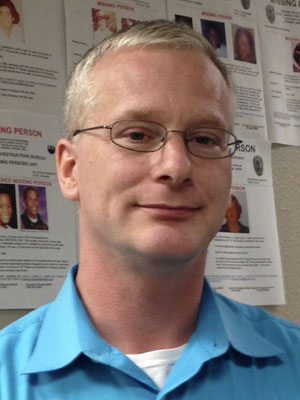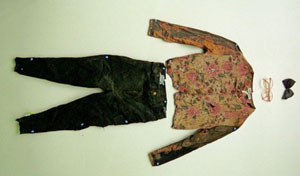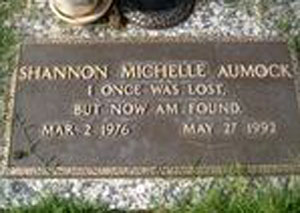 My name is Stuart Somershoe and I work for the City of Phoenix Police Department. I am a detective with the Missing and Unidentified Persons Unit. I got into law enforcement kind of a strange path. I graduated college with an English major. I ended up managing a bookstore and I was monumentally bored by that. It was the same thing every day in and out. My brother chose a different path and he ended up becoming a patrol officer in Los Angeles.
My name is Stuart Somershoe and I work for the City of Phoenix Police Department. I am a detective with the Missing and Unidentified Persons Unit. I got into law enforcement kind of a strange path. I graduated college with an English major. I ended up managing a bookstore and I was monumentally bored by that. It was the same thing every day in and out. My brother chose a different path and he ended up becoming a patrol officer in Los Angeles.
I went to visit him and did a couple of ride alongs and just really got hooked by it. Just the variety, the different calls that you got to on and just the excitement of it all kind of drew me to it. So, after that, I decided I was going to move into that career path. At the time I was living in Pennsylvania, so, I ended up going through a police Academy in Pennsylvania to get what they call “ACT 120 Certified” which is a certification you need to work for the police departments there. So I was going through a testing process for various departments there. My brother in the meantime had left Los Angeles and came to the Phoenix Police Department and he told me they were hiring. That particular year we were having one of our worst winters we ever had in Pennsylvania, and I was very tired of snow and cold. So I decided to come out to Phoenix and test. I tested in January of 1996, and by July I was in the police Academy.
I worked patrol for 12 years, third shift mostly, and then for about three years I was a field training officer. After that I tested for a detective position in the Missing Persons Unit (one of the positions in a police department) and I joined that at the end of 2007 and that’s where I’ve been since.
As missing persons unit we, handle all the incoming missing person cases, all the cases involving unidentified remains. So we are a very busy unit. We get about 7,000 cases a year of missing persons and those cases range all across the board. A vast majority of them are runaways or people who are willfully gone missing.
There are a smaller percentage of cases where people have met with foul play and we haven’t found a body or a crime scene yet. And so then you’re dealing with a challenging obstacle of proving a homicide has occurred in addition to proving who did it. Those are some of the most challenging cases you can deal with as a law enforcement officer, because you’re missing the basic element of a crime, a body. I find those very challenging and interesting. Our cases range from all demographics of society, the very rich and very poor, and all different backgrounds.
So you really get a taste of lots of different segments of society and a variety of people, it’s pretty interesting.
What is a Cold Case?
I like to focus on the cold cases. We have cases going back to 60’s and, some of those are very interesting cases. That’s kind of what I mainly do now is I work with cold cases involving missing and identified persons. The definition of a cold case is fluid. Traditionally, it’s a case that’s more than a year old where all leads have been exhausted. But we have missing person cases that come in where somebody reports their loved one is missing, where they haven’t seen them in years. So sometimes you have a cold case that comes in right away, where it’s so old that it basically by definition is a cold case. There’s a lot of variety in these kinds of cases and different routes of investigation that you do.
Challenges of Investigating a Cold Case
The challenges of a cold case are many. A lot of times you’re reconstructing things that happened long ago. I say sometimes as a cold case detective, you’re kind of like an archeologist where you’re trying to rebuild a case because in a lot of these cases they’re just police reports, and a lot of documentation outside of that is not preserved. I’ve spent time in cold cases going to the library to look at old newspaper articles to try to find witnesses and information about a case. I use Ancestry.com; I use newspapers.com, trying to gather information. Time can be an enemy in these cases in that you have witnesses that pass away, your suspects have passed away. Memories fade, and sometimes evidence gets lost, even though there’s not a lot of evidence in missing person cases, or it gets lost or destroyed. Those are some of the major challenges that you have.
How to Investigate a Cold Case
The way I investigate a cold case is I generally like to sit down with the whole case file and I’ll just read it from beginning to end without taking any notes or anything. I’ll just read it to get a sense of what the case is, and what’s still there. Then I’ll start back from the beginning and I’ll have a notepad with me, and that’s when I’ll start taking notes of things that I think need to be followed up on or avenues of investigation that could be followed. It’s always a good idea, I think, to read a cold case from beginning to end at least two times, if not more than that, because there’s a lot of details, a lot of, information that you may not glean from your first reading.
You also have to kind of step back from an investigation because in a lot of these cases there are prejudices or biases that sometimes creep in and that’s how human beings are. Sometimes an investigator will get blinders as they’re following a case and not really see a path that they should have followed. So it’s always good to step back and just kind of look at the case with fresh eyes and see hopefully things that weren’t noticed before.
I often tell people that cold cases are really just failures. However they should not reflect badly upon the original criminal investigator. There are many reasons why a case isn’t solved and I always try to not point fingers or lay blame upon a case from a prior investigator because that’s a fool’s game. What they did in the 1980s and 1990s is there a different process than what we have in the 2000’s. DNA wasn’t even a consideration back in some of these old cases. So you really can’t get upset because they were doing the best way they could. You try to just focus on what you can solve and what you can improve upon.
What drives Cold Cases
What drives cold cases are two things, changes in the technology and changes in relationships. Missing person cases are unique and that usually we don’t have a lot of evidence that can be retested with new technology. We’re dealing with an absence of evidence in missing persons cases. You don’t have a body, you don’t have a scene. You don’t have the traditional elements that drive other cold cases, homicide and sex crimes. Cold cases are really evidence driven. That’s where you have a piece of evidence that can be looked at again, can be retested, maybe get a DNA profile of an offender. And that’s what drives those cases. With missing person cases, we spend a lot of time re-interviewing witnesses, trying to see if there’s new information, possibly old alliances are no longer valid. An ex-wife is an excellent source of information in a cold case. So those are things we try to focus on.
Forensic Genealogy
The brave new frontier for cold cases is forensic genealogy. I use that in a number of my unidentified cases. We have a tremendous number of unidentified bodies in the United States. It’s estimated we have 40,000 unidentified bodies. In the United States it’s been called the nation’s silent mass disaster. In Arizona we have some of the highest (number of unidentified bodies) in the nation. We have almost 2,000 unidentified bodies. The reason for that is probably two-fold. One is that we’re close to the border and we have a lot of people crossing the desert and dying. But it’s also the environmental factor of being in a desert that rapidly degrades the body so it turns skeletal really quick and that makes identifying the body challenging. So forensic genealogy is a new investigative tool that can be used in these cases and what that is where we take a DNA profile. This has been used in cases such as the Golden State Killer case and the Canal Murder case here in Phoenix.
What happens is that you take a profile of a suspect or an unidentified victim and you upload it to some of the, databases that people are using for genealogy research, Anchestery.com, 23andme. Genealogists will then trace and look for family members that may be related to your offender or victim. And through that we’re able to make connections and then identify victims. That’s how I use it. So it’s opened a lot of doors in these cases and I think that’s going to be the wave of the future, that’s how we’re going to resolve a lot of these cold cases. I think it’s a significant and important advancement in investigations as DNA was originally.
An Unidentified Young Girl
I’m towards the end of my career. So at some point you look back and you say, well, what did I do? What did I accomplish? There’s one case that I often look back at it which I’m particularly proud of. So this case goes all the way back to May of 1992. It involves a young female who was murdered. When we started this case there was a young girl named Brandy Myers who went missing in May of 1992. She was walking through a neighborhood and trying to collect money for school book drive. She disappeared and it created this massive search effort to find Brandy.

The person who found the body had a misdemeanor warrant for his arrest so he didn’t want to talk to the police directly. But he rushes home and tells his roommates. “I think I found Brandy Myers” and they’re like, well, you need to call the police then. So he calls the police anonymously and coincidentally while this was all going on, there was a convention in Phoenix of search dogs and they were actually being utilized in the Brandy Myers search. So they took the search dogs out to where he was saying the body was found. They eventually found the body and it was mostly skeletal. She was clothed and she had been strangled. They quickly determined it wasn’t Brandy Myers based on the decomposition, because this is a day after Brandy went missing. But they didn’t know who this female was.
They checked missing person reports didn’t find any matches. The investigators back then did everything they could to identify this female. She was autopsied and an anthropologist analyzed her remains and found that she was a young female. They estimated between 12 and 16 years old. And that they believe that she was white based on the morphology of her skeleton. She was very young; she still had some of her baby teeth in her mouth. So based on that, they created a composite sketch and they released it to the media hoping that somebody will come forward and say, “Hey, I know who that girl is.” Nobody came forward. This went on for years and the case remained open and it was on America’s Most Wanted, it was released throughout the media as much as they could. Her DNA profile was uploaded into CODIS and there were no matches or anything like that. So it remained basically a cold case where we had an unidentified of a young girl.
In 2011 I was working missing persons and my emphasis was just on missing persons and I started to become interested in some of the unidentified cases that we had within our police department. So I went to my supervisor and I said, you know, look at all these cases that we have, a lot of them weren’t really being worked on because there’s always new cases coming in. So I kind of pitched the idea that this is something we should be working on. And we went from being the Missing Person’s Unit to the Missing and Unidentified Persons Unit. The reason for that is every unidentified person is to me is a missing person, and there’s somebody out there who’s missing this person.
I had given my boss, Bryan Chapman, a stack of some of these cases. He picked up this particular case from 1992 and he said, “well, if nothing else, we’re going to solve this case.” And I had already reviewed the case and I was like, I don’t know, it was going to be tough. So, we just kind of restarted that whole case and, worked on it.
Why isn’t there a Matching Missing Girl?

So that was the third theory is that maybe she’s one of these kids and somehow she fell between the cracks. So with these theories, we decided to pull a list of closed, missing juvenile reports. And the reason we did that is that, we know that there’s a certain pattern to a lot of these kids and it’s a sad. The pattern of what happens with a lot of these kids is you’ll see they get taken out of their home for whatever reason, for child abuse, sexual abuse and that sort of thing. And then they get placed in a foster home or a group home and that sort of thing. And then you start seeing little episodes of criminality and a lot of them are just straight survival crimes. There’s shoplifting, sometimes prostitution. And often after that the sad pattern is they just start running away all the time. A lot of that just leads to addiction and to a lot of other issues. So that’s the unfortunate flowchart pattern that you see in a lot of these cases.
1600 Missing Juvenile Reports to Review
So that’s why we grabbed a listing of closed, missing juvenile reports, and we asked for a listing of all reports from 1991 up to 1993 involving all the females of a particular heights and age. I ended up getting a list of 1600 reports, which is a lot of reports. It becomes a very tedious process of just going through those reports and running background checks on each person in those reports.
And what we’re looking for was proof of life after May of 1992. So if a juvenile was arrested sometime after that, we knew that they weren’t our Jane DOE or if they had an ID issued to them. Or there were some other report that we could say definitively that they are alive after May of 1992, they were crossed off the list. This took a long time going through all these reports and checking all these people. So as we would go through the list, we would have some that we couldn’t immediately cross off. We knew there’d have to be more research. So we made it through the 1600 reports and we had probably a little less than a hundred remaining.
One Missing Girl Stood Out

In April, 1992, Shannon was released from the detention center, given back to Child Protective Services, who then placed her in a foster home and then she ran away from that foster home. But unfortunately when she ran away from that foster home, but she wasn’t reported missing and she was never listed as a missing juvenile.
How to Prove the Unidentified Girl was Shannon
So basically there was nobody looking for Shannon. So when I found that pattern of reports and some other details, it made me think that this Jane DOE was Shannon. So then the challenge became how do we prove that this Jane DOE was Shannon. We were able to eventually track down her biological mother who gave her up for adoption and got a DNA sample from her.
I rushed it to the lab and the lab technician, Kelley Merwin, who had actually been working on this case for years. And she had the composite sketch on her desk because she had taken such an interest in the case. So she did a rush job on the DNA comparison and within days we did identify the Jane DOE has Shannon.

What makes a Good Cold Case Detective
The talents or skills of cold case detective, the attributes, are many. You really have to be a Jack of many trades. You have to be very self-driven, and you kind of have to have that fire in your belly to want to get justice and resolve these cases because they can be very frustrating. The skills that you’re going to need are an ability to write well, and you have to be able to communicate well. A lot of times in these cases, you have a suspect identified and you’ll get one shot at talking to them again. And you have to have the ability to talk to somebody for hours and hours and get them to confess to a homicide, and basically tell you something that’s going to lock them away for the rest of their lives. So that that takes a lot of communication skills and interview skills, interrogation skills.
But the other part of it is that you feel like an archeologist. Sometimes you have to be able to do research, find things, know where to look for things and recreate things from the past. I think a lot of people sometimes go into law enforcement with the idea that it’s gunfights and car chases and action like in the movies. The reality is that you have to really have good communication skills, both writing and verbal. Because you’re going to spend a lot of time writing and a lot of time talking to people. So those skills are really essential. I I’ve been doing this for 24 years and I’ve been in one gunfight. I’ve been in a few car chases. But I’ve spent a lot more time writing police reports and interviewing people then than those things. So that’s the things I would tell people to focus on and develop those skills. I went to college for English and that has helped me a lot to be able to write good reports, write search warrants, that sort of thing.
To Become a Cold Case Detective
To become a cold case detective is not something you’re going to do right away. Typically cold case detectives are more of your seasoned detectives. People who’ve been doing it for a lot of years. If you want to do that, and a lot of people do, there’s a lot of things you have to do before that. I always tell people, being a peace officer is one of the best schools that you can do to prepare yourself for investigations and cold case work. Just interacting with people and talking to people and developing those skills of being able to talk to somebody of any background and get them to confess things to you will help you immensely in this job. And just to get that basic foundation of life experience. So, if you go into law enforcement, have a goal of what you want to do and then start developing those talents and those skills and most police departments will assist you in that they want to develop their employees so they can assume these positions.
Whatever training the department offers, take it. Most of it is free and you can really develop your resume and your ability to do these jobs. Because these jobs will open. I’m near the end of my career. In a few years I’ll be retiring. So someone’s got to take my spot. I hope it’s somebody who’s more skilled and sharper than I am, so that they can solve the cases that I didn’t.
Related Links

 Joseph Libowsky,
Joseph Libowsky,